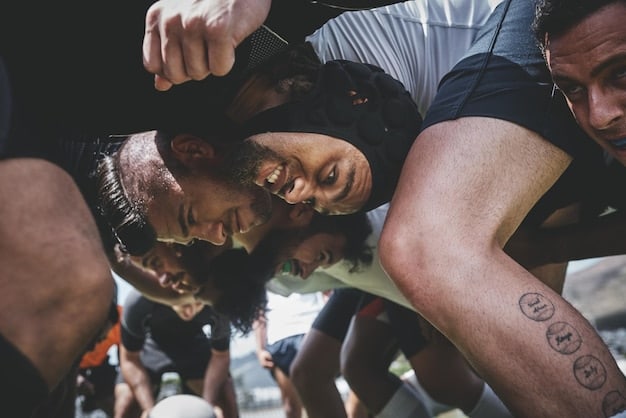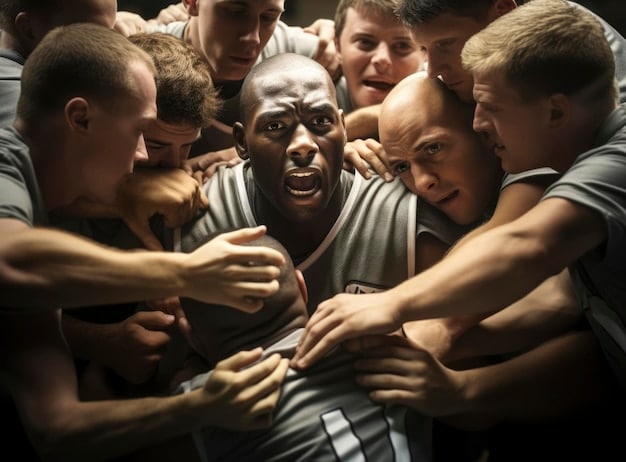Team Chemistry in High-Pressure Sports: Key Factors for Success

Achieving success in high-pressure sports environments critically hinges on a complex interplay of factors, with team chemistry standing out as a pivotal element influencing performance, resilience, and overall cohesion under duress.
In the exhilarating yet relentlessly demanding world of high-pressure sports, talent alone rarely guarantees triumph. While individual skill is undeniably crucial, the true differentiator often lies in something less tangible but profoundly powerful: what are the key factors that contribute to team chemistry and success in high-pressure sports environments? This intricate alchemy, where individual strengths coalesce into a formidable collective, defines dynasties and defies expectations.
The Foundational Pillars of Team Chemistry
Team chemistry is not some mystical force, but rather a cultivated dynamic built upon tangible elements that foster trust, communication, and mutual respect among athletes. It is the invisible thread that binds a group of individuals into a cohesive unit, allowing them to perform synchronously even when the stakes are highest. Understanding these foundational pillars is the first step toward intentionally building a winning culture.
Shared Vision and Goals
For any team to truly function as a cohesive entity, every member must be aligned, not just in their effort, but in their ultimate purpose. This alignment stems from a clear, compelling shared vision that resonates with each individual. It’s not enough to simply state “win the championship”; the vision must encompass the “how” and “why,” articulating the values and collective behaviors necessary to achieve that lofty goal. When every player genuinely buys into this singular objective, individual egos tend to recede, and the collective pursuit takes precedence. The emotional investment in a common destiny fuels commitment and collaboration, especially when adversity strikes.
This shared understanding doesn’t necessarily mean identical roles or contributions, but rather a unified direction. It means that the star player understands their role is part of a larger mechanism, and the role player recognizes their unique contribution is just as vital for the machinery to operate. The clearer and more consistently this vision is communicated and reinforced by leadership, the stronger the bond will be.
- Clarity of purpose: All team members clearly understand the overarching objective.
- Individual buy-in: Each player is personally invested in the collective goal.
- Aligned efforts: Personal and team priorities converge toward the same outcome.
Effective Communication Channels
Communication is often cited as the lifeblood of any successful team, and rightly so. In high-pressure sports, where split-second decisions and precise coordination are paramount, effective communication can mean the difference between victory and defeat. This extends beyond merely shouting instructions on the field; it encompasses open, honest, and respectful dialogue in every aspect of team life. Trust is built when players feel safe to voice concerns, offer feedback, and acknowledge mistakes without fear of retribution.
The best teams cultivate an environment where both direct and indirect communication are valued. This includes active listening, non-verbal cues, and the ability to adapt communication styles to different personalities within the team. Misunderstandings are minimized, fostering a sense of psychological safety that allows athletes to take risks and perform freely. When communication breaks down, even the most talented individuals can find themselves isolated, leading to fractured efforts and diminished performance.
Leadership and Role Clarity within the Team Dynamic
Beyond individual talent, the structure through which that talent is organized and motivated plays a critical role in team success, especially under pressure. Two elements stand out: robust leadership and crystal-clear understanding of individual roles. These are not static attributes but dynamic processes that require continuous nurturing.
Coaching Philosophy and Leadership Style
The coach, often the ultimate architect of team culture, profoundly influences chemistry. A consistent, transparent, and empathetic coaching philosophy establishes the framework within which chemistry can flourish. Coaches who prioritize communication, psychological safety, and growth over mere wins and losses tend to cultivate stronger bonds. Their leadership style can either empower players or stifle individual initiative. Authoritarian approaches might yield short-term results but rarely foster the deep, intrinsic motivation necessary for sustained high-pressure performance. Conversely, a democratic or collaborative style, while requiring more initial investment, can build profound trust and shared ownership.
Effective leadership also means leading by example. Coaches who demonstrate the values they preach – resilience, accountability, and respect – earn the genuine admiration and loyalty of their athletes. They are not just strategists but also mentors, guiding personal development alongside athletic prowess. This holistic approach strengthens the human connections within the team, making them more resilient during moments of truth.

Defined Roles and Individual Accountability
In any complex system, clarity of function is paramount. A sports team is no different. When every player understands their specific role, the expectations tied to it, and how it contributes to the larger team objective, ambiguity – a major contributor to anxiety and friction – is significantly reduced. This clarity instills confidence and allows players to focus their energy on executing their assigned tasks effectively, rather than second-guessing their place or responsibilities.
Beyond role definition, strong team chemistry demands unwavering individual accountability. This means players not only understand their responsibilities but also take ownership of their performance, both successes and failures. It’s about personal responsibility within a collective context. When a teammate falters, the focus shifts not to blame, but to collective support and problem-solving, acknowledging that everyone is part of a larger, interconnected machine. This mutual accountability strengthens bonds rather than fracturing them, as trust is built on reliability and shared commitment to excellence.
- Clear assignment of tasks: Each player knows what is expected of them specifically.
- Responsibility for outcomes: Individuals take ownership of their performance.
- Peer accountability: Teammates hold each other to high standards, constructively.
Psychological Resilience and Adaptability Under Duress
High-pressure environments are defined by their capacity to expose weaknesses. Teams that excel in these situations aren’t just physically skilled; they are psychologically robust, able to absorb setbacks and adapt on the fly. This mental fortitude is deeply intertwined with team chemistry, as collective resilience often mirrors individual psychological strength, magnified by mutual support.
Coping Mechanisms and Stress Management
The ability to manage stress and pressure effectively is a hallmark of elite athletes and teams. Team chemistry provides a built-in support system for this. When athletes feel connected and supported by their peers and coaches, they are better equipped to handle the immense psychological demands of competition. Shared experiences of overcoming adversity can forge unbreakable bonds, providing a collective reservoir of resilience. Teams that train not just physically, but mentally – practicing mindfulness, visualization, and debriefing strategies – develop a shared vocabulary and understanding of stress, enabling them to navigate it more effectively together.
This includes not just formal mechanisms but also informal peer support. A simple encouraging word from a teammate, a shared laugh, or a moment of solidarity can dissipate tension and re-center focus. These micro-interactions, cumulative over time, build the social capital that teams draw upon during moments of intense pressure. They create an environment where stress is not stigmatized but acknowledged and collectively managed.
Adaptability and In-Game Adjustments
Sports, particularly at the elite level, are dynamic and unpredictable. Strategies need to evolve, and players must adapt to changing circumstances, opponent tactics, and game flow. Team chemistry fosters this adaptability. When players trust each other and have open communication, they can quickly read and react to situations, making necessary in-game adjustments with minimal friction. This collective intelligence allows teams to pivot seamlessly, leveraging each other’s insights and strengths in real-time.
An adaptable team is one where players are not rigidly fixed to their initial roles but are willing and able to step outside their comfort zones if the situation demands it. This fluidity is only possible when there is a strong foundation of trust and a shared understanding of the overarching game plan. Without this, sudden changes can lead to confusion, hesitant play, and unforced errors, precisely when precision is most critical. The collective “feel” for the game, sharpened by countless hours of training and fostered by strong interpersonal dynamics, becomes a powerful force for in-game problem-solving.
Trust, Empathy, and Conflict Resolution
At the heart of any deeply connected group lies the fundamental element of trust. In sports, this trust extends beyond believing a teammate will make the right pass; it’s about believing in their character, their commitment, and their intent. When trust is absent or fractured, even the most talented components can fail to integrate effectively, leading to internal strife that can cripple performance.
Building and Maintaining Trust Among Teammates
Trust is not given; it is earned through consistent, reliable behavior over time. For athletes, this means showing up, putting in the work, supporting teammates, and demonstrating integrity both on and off the field. Trust allows players to take risks, knowing their teammates have their back. It facilitates vulnerability, enabling athletes to admit mistakes or weaknesses, which is crucial for growth and collective problem-solving. A team united by trust can weather storms that would tear lesser groups apart, because they believe in the fundamental good intentions of their peers.
Breaking down existing trust or failing to cultivate it can have devastating consequences. Cliques can form, communication can become guarded, and individual performance can suffer as players become more concerned with self-preservation than collective success. Therefore, investing in activities and fostering environments that explicitly build and reinforce trust is not an optional add-on but a core strategic imperative for high-performing sports teams.
Empathy and Understanding Individual Differences
Every team is composed of individuals with unique backgrounds, personalities, and perspectives. Great team chemistry thrives not on uniformity, but on a deep, empathetic understanding and appreciation of these differences. Empathy allows teammates to step into each other’s shoes, to understand motivations, and to offer support tailored to individual needs. It helps mitigate misunderstandings and build stronger bonds, as players feel seen and valued for who they are, not just for what they can do on the field.
Developing empathy on a team requires intentional effort, including team-building exercises, opportunities for personal sharing, and leadership that models empathetic behavior. It helps players navigate potential conflicts by fostering a mindset of understanding rather than judgment. When adversity strikes, or when performance dips, empathy encourages support and coaching rather than criticism and blame, reinforcing the positive feedback loops essential for sustained high performance.
- Active listening: Truly hearing and understanding teammates’ perspectives.
- Perspective-taking: Imagining how situations feel from another’s point of view.
- Tailored support: Providing assistance that meets individual needs.
Constructive Conflict Resolution
Conflict is an inevitable part of any human endeavor, and sports teams are no exception. What distinguishes successful teams is not the absence of conflict, but their ability to resolve it constructively. Team chemistry provides the framework for this. When trust and communication are strong, disagreements can be voiced openly and addressed directly, focusing on solutions rather than personal attacks. A healthy team views conflict as an opportunity for growth and refinement, rather than a threat to cohesion.
Effective conflict resolution mechanisms include clear protocols for addressing issues, mediation when necessary, and a collective commitment to moving forward. Leaders, both coaches and senior players, play a crucial role in facilitating these processes, ensuring that all voices are heard and that resolutions are fair and beneficial to the team as a whole. Teams that sweep conflict under the rug or allow it to fester will inevitably see their chemistry erode, leading to passive aggression, resentment, and ultimately, poorer performance.
Shared Experiences and Culture Building
Beyond the strategic and psychological elements, the very fabric of team chemistry is woven from shared experiences and the deliberate cultivation of a unique team culture. These are the elements that give a team its distinct identity and reinforce the bonds that hold it together through thick and thin.
Team-Building Activities Beyond the Sport
While competition and training naturally foster some level of camaraderie, intentionally designed team-building activities outside the realm of the sport itself can significantly accelerate and deepen connections. These activities – whether they are adventure outings, community service projects, or simply shared meals – provide opportunities for players to see each other as people, not just athletes. They break down social barriers, reveal different facets of personalities, and create shared memories that become part of the team’s collective story.
These experiences offer a low-stakes environment for trust to develop and for communication styles to be explored without the immediate pressure of competition. The laughter, the problem-solving, and the shared vulnerability in these contexts translate directly into stronger bonds and better communication when under pressure on the field. They contribute directly to the “we-ness” that defines strong team chemistry, creating a sense of solidarity that transcends win-loss records.
Rituals and Traditions
Every successful group, from families to nations, has rituals and traditions that reinforce its identity and values. Sports teams are no different. These rituals, whether they are pre-game routines, specific celebrations, or even shared insider jokes, create a sense of belonging and continuity. They are anchors in the often chaotic world of high-pressure sports, providing comfort and a shared sense of purpose. Traditions can range from the trivial to the deeply meaningful, but all serve to reinforce the idea of a collective, shared identity.
These cultural artifacts are more than just superstitions; they are powerful reminders of shared history, values, and triumphs. They offer common ground, foster a sense of psychological safety, and serve as mnemonic devices for the team’s journey together. In high-pressure moments, reverting to familiar rituals can help ground players, reduce anxiety, and reconnect them to the collective strength of the group, enhancing focus and performance.
Sustaining Chemistry Through Highs and Lows
Team chemistry is not a static state; it is a living, breathing entity that requires constant attention and renewal. Like any relationship, it can be tested by success and shattered by failure if not properly managed. Sustaining this dynamic through the inevitable ups and downs of a competitive season is a defining characteristic of truly great teams.
Navigating Success and Failure
Both success and failure pose unique challenges to team chemistry. Unchecked success can breed complacency, ego, and internal friction as credit is unevenly distributed. Conversely, protracted failure can lead to blame, despair, and fractured relationships. Great teams manage both with grace and intentionality. In success, they remain humble, united, and focused on continuous improvement, ensuring that individual achievements are celebrated within the context of collective effort.
In moments of failure, they lean into their chemistry. Instead of pointing fingers, they engage in honest self-assessment, renew their commitment to each other, and draw strength from their shared bonds. They view setbacks as learning opportunities, fostering resilience rather than despair. The ability of a team to rally after a significant loss and remain united is a profound testament to the strength of its chemistry, demonstrating an underlying belief in each other and the collective purpose.

Continuous Feedback and Adaptation
Just as athletes require continuous feedback to refine their skills, team chemistry benefits from ongoing assessment and adaptation. This includes regular opportunities for players to provide feedback to leadership and to each other, both formally and informally. An open-door policy, anonymous surveys, and structured team meetings can all contribute to a culture of continuous improvement, where issues are identified and addressed before they fester.
Furthermore, a dynamic team culture understands that chemistry, like strategy, must evolve. As new players join, and as the team faces different challenges, the dynamics will inevitably shift. The ability to recognize these shifts and adapt the approach to fostering chemistry – whether that means new team-building activities, changes in communication protocols, or adjustments to leadership styles – is critical for long-term sustained success in high-pressure environments. Stagnation is the enemy of chemistry; continuous evolution is its lifeblood, ensuring the team remains vibrant, cohesive, and ready for whatever comes next.
| Key Factor | Brief Description |
|---|---|
| 🤝 Unified Vision | Every team member shares and commits to common goals for collective success. |
| 🗣️ Open Communication | Honest and continuous dialogue builds trust and minimizes misunderstandings. |
| 🧠 Psychological Resilience | Ability to manage stress, adapt to pressure, and recover from setbacks collectively. |
| ⚙️ Role Clarity & Trust | Defined responsibilities and mutual confidence enhance performance and cohesion. |
Frequently Asked Questions About Team Chemistry
▼
While individual talent is essential, team chemistry amplifies it. In high-pressure situations, individual errors can multiply without a cohesive support system. Strong chemistry ensures players trust each other, communicate effectively, and collectively problem-solve, transforming individual skills into synchronized, high-impact performance that can withstand duress. It fosters resilience and adaptability crucial for overcoming adversity.
▼
Team chemistry can and should be actively built and nurtured. While some natural connections may form, intentional strategies like shared goal setting, leadership development, structured communication protocols, and off-field team-building activities are vital. Coaches and team leaders play a proactive role in creating an environment where trust, empathy, and open dialogue can flourish, guiding its development rather than leaving it to chance.
▼
Conflict is inevitable in any group, and how it’s handled is critical for team chemistry. Effective conflict resolution ensures that disagreements are addressed constructively, preventing resentment and fostering growth. When teammates trust that issues will be resolved fairly and respectfully, it strengthens their bonds rather than breaking them. It allows teams to navigate challenges as opportunities for refinement, reinforcing mutual respect and understanding.
▼
Shared experiences, both triumphs and adversities, are the bedrock of deep team chemistry. Overcoming challenges together, celebrating victories, and enduring setbacks create a common history and a sense of collective identity. These moments forge emotional bonds that individual training sessions simply cannot replicate. They build psychological capital, providing a wellspring of trust and camaraderie that teams draw upon during moments of intense pressure, strengthening their resolve.
▼
Signs of faltering team chemistry under pressure include increased individual play, blaming or finger-pointing, breakdown in communication (both on and off the field), a noticeable lack of empathy or support among teammates, and an inability to collectively bounce back from mistakes or adversity. These symptoms often cascade, leading to a loss of focus, decreased trust, and ultimately, a decline in overall team performance when it matters most.
Conclusion
The pursuit of success in high-pressure sports environments is a multifaceted endeavor, yet the role of team chemistry emerges as a consistent and paramount determinant. It is the intangible force that binds individual brilliance into collective supremacy, transforming mere talent into triumphant performance. From a unified vision and open communication to robust leadership, defined roles, and psychological resilience, each factor contributes significantly to weaving the intricate tapestry of a cohesive and successful team. Ultimately, sustained success is less about a collection of stars and more about a constellation of individuals aligned in purpose, powered by trust, and cemented by shared experiences, enabling them to shine brightest when the stakes are highest.





